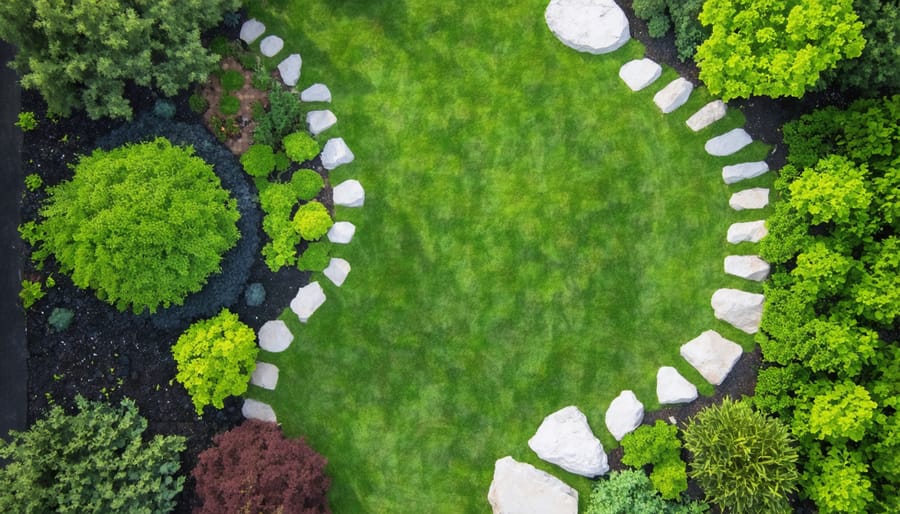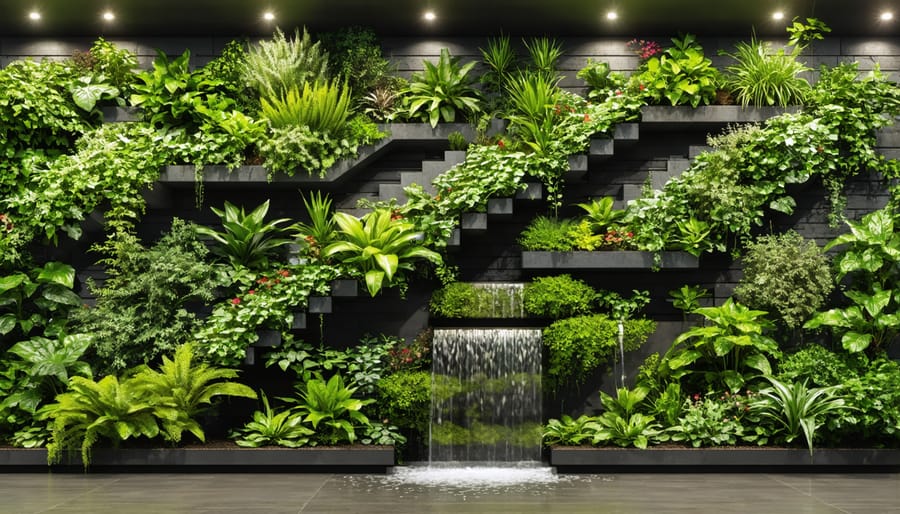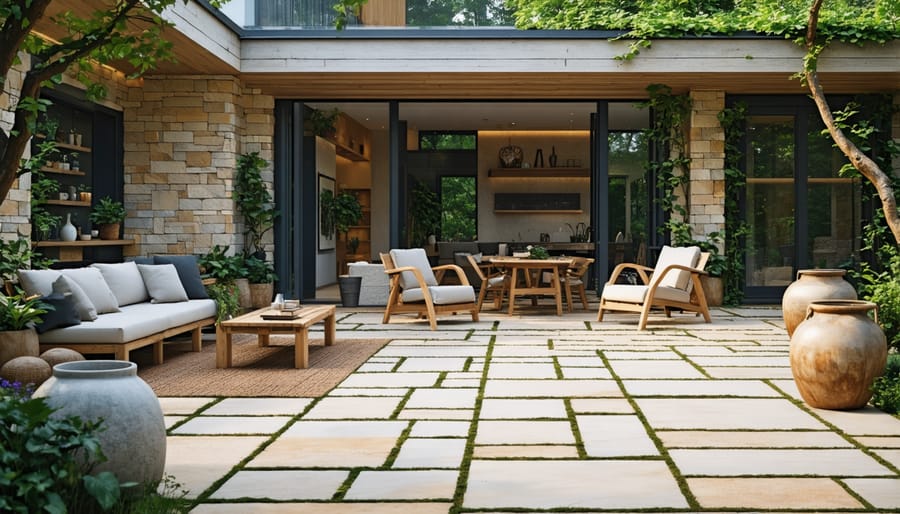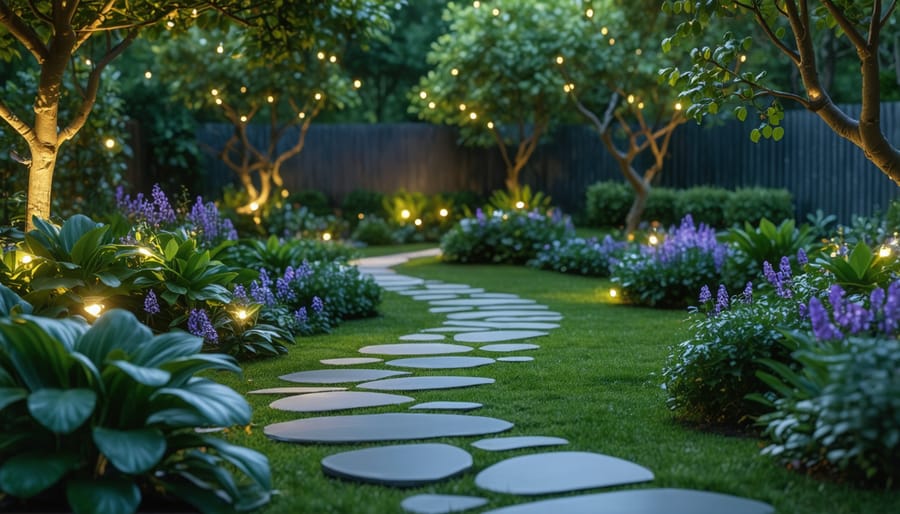Transform your outdoor space into a natural sanctuary by first mapping sun patterns, wind direction, and existing vegetation to determine optimal seating and activity zones. Layer your design with defined functional areas – cooking, dining, lounging, and contemplative spaces – connected by intuitive pathways that mirror natural foot traffic patterns. Select weather-resistant materials that complement your home’s architecture while incorporating native plants and sustainable features like permeable pavers or rain gardens. Create visual harmony through repeated elements like matching container gardens, consistent lighting fixtures, and cohesive color schemes that draw inspiration from the surrounding landscape.
Building outdoor rooms requires the same thoughtful consideration as interior spaces, but with an added focus on environmental factors and seasonal changes. Whether you’re working with a compact urban patio or an expansive backyard, successful outdoor living spaces blend seamless functionality with organic beauty, providing year-round enjoyment and a deeper connection to nature. The key lies in striking the perfect balance between structured comfort and wild beauty, creating spaces that feel both designed and naturally evolved.
Creating Your Natural Foundation
Site Analysis and Planning
Before diving into your outdoor living space design, taking time to analyze your site is crucial for creating a space that works with nature, not against it. Start by observing how sunlight moves across your yard throughout the day – this will help you position seating areas and determine which plants will thrive where.
Consider your local climate and weather patterns. Does your area experience strong winds? Are there frequent rain showers? Understanding these factors will influence your choice of materials and help you plan for proper drainage and shelter.
Take stock of existing vegetation and natural features. Mature trees provide valuable shade and can become focal points in your design. Note any slopes or uneven terrain, as these might require terracing or strategic placement of retaining walls. Don’t forget to check your soil type – this affects both plant selection and construction stability.
Map out utility lines and consider access points to your home. You’ll want to ensure your design doesn’t interfere with underground pipes or electrical lines. Also, think about views – both what you want to highlight and what you might want to screen from sight.
Finally, observe how you naturally move through your outdoor space. The most successful designs often build upon existing traffic patterns and incorporate features that complement your lifestyle and the way you plan to use the space.
Working with Natural Topography
Working with your yard’s natural topography isn’t just cost-effective – it’s the secret to creating an outdoor space that feels like it’s always belonged there. Start by walking your property and noting the natural flow of the land, including slopes, flat areas, and any existing features like rock formations or mature trees.
Instead of fighting against slopes, embrace them by creating terraced areas using retaining walls or natural stone. These levels can serve different purposes – perhaps a dining area on the upper terrace and a cozy seating nook below. For steeper inclines, consider installing curved pathways that follow the natural contours of the land, making navigation both easier and more aesthetically pleasing.
Low-lying areas can be transformed into rain gardens or dry creek beds, turning potential drainage issues into beautiful landscape features. If you have natural rock formations, incorporate them into your design as focal points or seating areas. Existing trees can become anchors for your outdoor living space, providing natural shade and structure.
Remember to consider how water naturally flows across your property. Working with this flow rather than against it will help prevent erosion and drainage problems while creating a more sustainable outdoor environment. By respecting and enhancing your yard’s natural features, you’ll create an outdoor living space that feels authentic and requires less maintenance over time.

Living Elements That Define Your Space
Native Plant Selection
Selecting native plants for your eco-friendly outdoor space isn’t just a trend – it’s a smart approach to creating a sustainable and low-maintenance landscape. Native plants have evolved to thrive in your local climate, requiring less water, fertilizer, and overall care than non-native species.
Start by researching plants indigenous to your region through local nurseries or botanical gardens. Consider factors like sunlight exposure, soil type, and seasonal changes when making your selections. Mix different heights and textures – tall grasses can provide privacy, while ground covers prevent soil erosion and reduce water needs.
Include flowering natives that bloom at different times to ensure year-round color and support local pollinators. Native shrubs and small trees can create natural borders while providing shelter for birds and beneficial insects. For example, butterfly bushes attract beautiful pollinators, while berry-producing plants offer food for local wildlife.
Group plants with similar water needs together to create efficient watering zones. Consider incorporating native drought-resistant plants in areas that receive full sun, and shade-loving natives under tree canopies. Remember that while native plants are generally hardy, they still need proper care during their establishment period – typically the first growing season.
By choosing local flora, you’re not just creating a beautiful outdoor space; you’re contributing to your local ecosystem while saving time and resources on maintenance.
Water Features and Natural Sound
Water features bring a sense of tranquility and natural beauty to your outdoor space, transforming it into a peaceful retreat. A gentle fountain or bubbling stream creates a soothing soundtrack that helps mask urban noise while attracting local wildlife to your garden.
Start small with a tabletop fountain if you’re new to water features. These are easy to maintain and can be moved around to find the perfect spot. For a more dramatic impact, consider installing a wall fountain or cascading waterfall that becomes a focal point in your design.
Natural ponds create incredible ecosystems that attract birds, butterflies, and dragonflies. Add native aquatic plants like water lilies and marsh marigolds to create a balanced environment. Remember to include varying water depths to support different types of wildlife and ensure proper circulation to maintain water quality.
For a modern twist, try incorporating a rill – a narrow water channel that guides water through your garden. These architectural features combine the visual appeal of moving water with clean, contemporary lines. LED lighting can transform your water feature into a stunning nighttime display.
When planning your water feature, consider maintenance requirements and seasonal care. Installing a reliable pump system and filtration unit will keep your water clear and healthy. In colder climates, prepare to winterize your features or choose designs that can withstand freezing temperatures.
Living Walls and Vertical Gardens
Transform your outdoor space into a lush, vertical oasis with living walls and vertical gardens. These innovative gardening solutions are perfect for maximizing green space in any outdoor area, whether you have a tiny balcony or a spacious patio.
Start by choosing the right system for your space. Self-watering modular panels offer a low-maintenance option, while pocket planters provide flexibility for changing your design. For beginners, try a simple trellis system with climbing plants like jasmine or ivy. More ambitious gardeners might opt for complete living wall systems with built-in irrigation.
When selecting plants, consider your climate and sun exposure. Mix different textures and colors for visual interest – try combining ferns, succulents, and flowering perennials. Some excellent choices include sedum, heuchera, and creeping thyme. Layer your plants strategically, placing taller varieties at the top and trailing plants at the bottom.
Remember to install a proper irrigation system. Drip systems work well for most vertical gardens, ensuring even water distribution. Include a timer to maintain consistent moisture levels and reduce maintenance needs.
For the best results, place your living wall where it can be easily maintained and enjoyed. Consider positioning it as a natural privacy screen or as a stunning backdrop for your seating area. Regular pruning and fertilizing will keep your vertical garden thriving and looking its best throughout the seasons.

Sustainable Materials and Natural Textures
Organic Building Materials
Natural materials bring warmth, authenticity, and timeless appeal to your outdoor living space. Wood remains a top choice, with cedar and teak offering excellent weather resistance and a beautiful patina as they age. For decking and furniture, consider sustainably harvested hardwoods that require minimal maintenance while providing lasting durability.
Stone elements create a seamless connection with the surrounding landscape. Whether you’re using flagstone for pathways, slate for accent walls, or river rock for garden borders, each type of stone brings its unique character to your space. Mix different stone sizes and textures to create visual interest and natural flow.
Bamboo offers an eco-friendly alternative for privacy screens and pergolas, growing quickly and providing a modern yet organic feel. For smaller accents, consider incorporating natural rope, jute, or wicker elements in your furniture and decorative pieces.
When combining materials, focus on complementary textures and colors that occur naturally in your environment. For example, pair smooth river stones with rough-cut timber, or combine weathered wood with polished granite. This thoughtful mixing of materials creates a cohesive look that feels both designed and naturally evolved.
Remember to consider your climate when selecting materials. Some woods may require more maintenance in humid areas, while certain stones might not fare well in freeze-thaw cycles. Choose materials that not only look beautiful but will stand up to your local weather conditions.
Eco-Friendly Furniture Selection
When creating your outdoor oasis, choosing sustainable outdoor furniture isn’t just good for the planet – it’s a smart investment in style and durability. Start by looking for pieces made from responsibly sourced materials like FSC-certified teak, reclaimed wood, or recycled plastics. These materials not only stand up to the elements but also create a beautiful, natural aesthetic that enhances your outdoor space.
Consider bamboo furniture for its rapid renewability and modern appeal, or explore options made from recycled metal and plastic materials that give new life to waste products. Many eco-conscious manufacturers now offer stunning designs that combine sustainability with weather resistance and style.
Look for pieces treated with non-toxic finishes and stains that can withstand outdoor conditions while remaining environmentally friendly. Multi-functional furniture, like storage benches or convertible tables, helps maximize space efficiency while minimizing environmental impact.
Don’t forget about maintenance – choose pieces that can be easily cleaned with natural products and require minimal upkeep. Local craftsmen often create beautiful custom pieces from reclaimed materials, adding unique character to your space while supporting your community.
Remember to consider the full lifecycle of your furniture. Opt for classic, timeless designs that won’t go out of style, and look for pieces that can be easily repaired or recycled at the end of their life.

Seamless Indoor-Outdoor Transitions
Natural Flow Design
Creating a seamless flow between your indoor and outdoor spaces isn’t just about aesthetics – it’s about expanding your living area and embracing nature in your daily life. Start by identifying natural transition points, like sliding glass doors or French doors, which can serve as gateways to your outdoor oasis.
Consider using consistent flooring materials that extend from inside to outside, such as weather-resistant tiles or decking that complements your interior floors. This visual continuity helps blur the boundaries and creates an inviting pathway between spaces. Installing large windows or glass walls can frame outdoor views and bring natural light inside, making both areas feel more connected.
Design your outdoor space as a natural extension of your interior rooms. If your indoor living room faces the patio, arrange outdoor furniture to mirror the indoor seating arrangement. Use weather-resistant fabrics and materials that echo your interior color scheme while standing up to the elements.
Level changes can add interest but keep them minimal near transition areas. Consider using similar design elements like lighting fixtures, throw pillows, and decorative items that work in both environments. Adding potted plants both inside and outside creates a gentle transition and brings nature into your home.
For year-round enjoyment, incorporate features like retractable awnings or pergolas that provide shelter while maintaining the open-air feeling. Remember, successful indoor-outdoor flow should feel effortless and natural, encouraging movement between spaces throughout the day.
Seasonal Adaptability
Creating a space that embraces year-round outdoor living requires thoughtful planning and versatile design elements. Start by incorporating adjustable covering solutions like retractable awnings or pergolas with removable canvas tops that can provide shade in summer and allow precious sunlight during winter months.
Consider installing outdoor heating options such as a fire pit, infrared heaters, or a built-in fireplace for cooler seasons. These not only provide warmth but also create natural gathering points throughout the year. For summer comfort, integrate cooling features like misting systems or strategically placed fans.
Choose weather-resistant furniture and fabrics that can withstand various conditions, and invest in protective covers for especially harsh weather. Create windbreaks using natural elements like strategic plantings or decorative screens that can shield your space from chilly breezes while maintaining aesthetic appeal.
Storage solutions are crucial for seasonal transitions. Include weather-proof storage boxes or a small shed to keep cushions, throws, and seasonal décor protected when not in use. Consider modular furniture that can be easily rearranged to accommodate different activities and weather conditions.
For maximum enjoyment, incorporate features that work across seasons: drought-resistant plants that provide year-round interest, lighting that creates ambiance in any weather, and versatile seating arrangements that can adapt to both intimate gatherings and larger social events.
Natural Lighting Solutions
Solar and LED Integration
Blending sustainable lighting into your outdoor space not only reduces energy costs but also creates a magical ambiance that enhances your natural surroundings. Modern solar-powered garden lighting has come a long way, offering elegant solutions that charge during the day and automatically illuminate your space at dusk.
Consider strategically placing LED strip lights under bench seating or along pathways to create subtle guidance through your outdoor areas. Solar-powered stake lights work wonderfully along garden borders, while LED lanterns can be hung from trees or pergolas to create intimate dining spaces.
For maximum efficiency, opt for motion-sensor LED fixtures near entryways and utility areas. These smart solutions provide security while conserving energy. Combine different lighting types to create layers – use softer, warm LEDs for ambient lighting and brighter, focused beams for task areas like outdoor kitchens or reading nooks.
Remember to position solar panels where they’ll receive maximum sunlight during the day, and clean them periodically to maintain optimal charging capacity. This thoughtful integration of sustainable lighting not only reduces your carbon footprint but also extends your outdoor living hours well into the evening.
Moonlight Gardens
Transform your outdoor space into an enchanting nighttime retreat by designing a moonlight garden that captures the magic of evening hours. Start by selecting plants with light-colored blooms and silvery foliage that naturally reflect moonlight, such as white petunias, silver sage, and fragrant night-blooming jasmine.
Strategic lighting is key to creating the perfect ambiance. Install soft, downward-facing LED landscape lights to minimize light pollution while highlighting pathways and garden features. Consider solar-powered lights that naturally transition from day to night, maintaining your garden’s eco-friendly appeal.
Incorporate reflective elements like mirrors, metallic sculptures, or a small water feature to amplify natural moonlight. Light-colored gravel or stepping stones can create luminous paths that seem to glow in the evening. Don’t forget to add comfortable seating areas where you can enjoy the peaceful atmosphere.
For added enchantment, include plants known for their evening fragrance, such as evening primrose or moonflowers. These night-blooming varieties release their sweet scents as the sun sets, creating a multi-sensory experience perfect for evening entertainment or quiet reflection.

Creating your perfect outdoor living space is an exciting journey that combines creativity, functionality, and a deep connection with nature. By carefully considering elements like natural materials, sustainable design principles, and your unique lifestyle needs, you can transform any outdoor area into a welcoming retreat that seamlessly blends with its surroundings.
Remember that successful outdoor spaces don’t happen overnight. Start with a solid plan, focusing on one area at a time, and allow your space to evolve naturally. Whether you’re working with a sprawling backyard or a cozy balcony, the key is to create harmony between built elements and the natural environment.
Don’t be afraid to experiment with different textures, materials, and plant combinations until you find what works best for your space. Consider incorporating local plants, sustainable materials, and weather-appropriate furnishings to create a space that’s both beautiful and practical.
Take that first step today – whether it’s sketching out your dream design, selecting your first plants, or simply rearranging your existing outdoor furniture. Your perfect natural outdoor living space awaits, ready to provide years of enjoyment and connection with the great outdoors.
